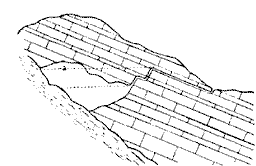 |
Science Frontiers ONLINE No. 71: Sep-Oct 1990 |
|
|
Wyoming: a periodic spring

"Near the base of a limestone cliff in Wyoming's Bridger-Teton National Forest, spring water gushes from an opening for several minutes, stops abruptly, then begins a new cycle a short time later. This is Periodic Spring, whose intermittent flow is a rare geologic phenomenon. The water is cold and clear, an indication that this is not a geyser like Old Faithful; such geysers, of volcanic origin, send forth hot water. Through the years various observers have timed the flows at anywhere from four to twentyfive minutes, with similarly varying dry spells. The intermittent flow is especially regular in late summer and autumn. During stormy periods or when there is heavy snow melt-off, the flow fluctuates but does not stop entirely."
At full flow, Periodic Spring discharges about 285 gallons/second into a stream 9� feet wide and 1� feet deep. Periodic Spring, therefore, is fairly impressive, but it is not anomalous. (Mohlenbrock, Robert H.; "Periodic Spring, Wyoming," Natural History, 99: 110, April 1990.)
Comment. Siphon action nicely explains periodic springs. Water keeps flowing through the upper loop until the water level in the reservoir drops below the siphon intake. The spring will not flow again until the reservoir fills to the top of the upper loop(level a) again initiating siphon action. Siphon action seems simple and easy to explain; why mention it here? Well, spherical pendulums are ostensibly simple, too, but we now know that they sometimes run amok and chaotic motion develops. Like Old Faithful Geyser, there is a possibility that periodic springs also may exhibit chaotic behavior on occasion.